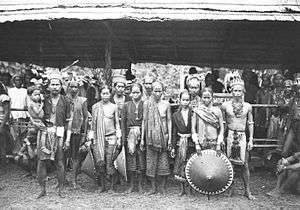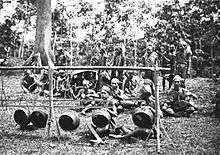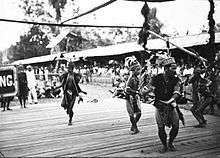Dayak Mualang
 A group of Mualang Dayaks during a visit to Governor-General J.P. Graaf of Limburg Stirum in Borneo, circa 1920. | |
| Total population | |
|---|---|
| 44,400[1] | |
| Regions with significant populations | |
|
| |
| Languages | |
| Mualang language, Indonesian language | |
| Religion | |
| Kaharingan (predominantly), Christianity | |
| Related ethnic groups | |
| Iban people |
Mualang (also Moealang or Dayak Mualang) are indigenous people of Borneo from the Dayak group and a sub-ethnic of the Iban people.[2] They speak Mualang language and they are mostly concentrated in areas in Sekadau Regency and Sintang Regency, West Kalimantan, Indonesia namely:-
- Belitang Hilir district, Sekadau
- Belitang district, Sekadau
- Belitang Hulu district, Sekadau
- Sepauk, Sintang and its surrounding region
Language
The language spoken by the Mualang people belongs to the Ibanic languages branch along with other Ibanic dialects such as Kantuk, Bugao, Desa, Seberuang, Ketungau, Sebaruk and so on.[3] The difference is in the pronunciation and accent for words that is used by other Ibanic sub-ethnics. For example, words that end with "i" changed to "e" or "y" such as "kediri" becomes "kedire", "rari" becomes "rare", "inai" becomes "inay", and "pulai" becomes "pulay". These words still carry the same meaning although it is pronounced differently.
Culture
Traditional Folk Song

Traditional Dance

- Mualang Ngajad Kayau, a warrior dance[7]
- Tari Pingan Mualang / Tari Pireng Mualang, found in Belitang Ilek, Belitang Tengah and Belitang Hulu
- Tari Pedang Mualang / Ngajat Bebunoh, a war dance performed by men found throughout Belitang Ilek (Merbang and its surrounding) and Belitang Hulu (Sebetung and its surrounding)[8]
- Ajat Temuai Datai, loosely translated as "Welcoming Guest" dance performed by couples and it is found in Belitang Ilek, Belitung Tengah, Belitung Hulu and its surrounding region[9]
Handicraft
References
- ↑ "Mualang in Indonesia". Joshua Project. Retrieved 2014-09-26.
- ↑ Leo Suryadinata, Evi Nurvidya Arifin & Aris Ananta (2003). Indonesia's Population: Ethnicity and Religion in a Changing Political Landscape. Institute of Southeast Asian Studies. ISBN 981-230-212-3.
- ↑ Johnny Tjia (2007). A Grammar of Mualang: An Ibanic Language of Western Kalimantan, Indonesia. LOT Publications. ISBN 978-90-78328-24-7.
- ↑ "Lagu Dayak Kalimantan Barat ( Meh Bujang Dayak Mualang )". YouTube. Retrieved 2014-09-26.
- ↑ "Lagu Dayak Kalimantan Barat ( Judul The Kutak Katik Bahasa Mualang )". YouTube. Retrieved 2014-09-26.
- ↑ "Lagu Dayak Kalimantan Barat ( Aboh Beramay Bahasa Mualang )". YouTube. Retrieved 2014-09-26.
- ↑ "Dayak Dance / Tari Dayak ( Mualang Ngajad Kayau ) Kalbar". YouTube. Retrieved 2014-09-26.
- ↑ Benedict Sandin (1980). Iban Adat and Augury. Penerbit Universiti Sains Malaysia for School of Comparative Social Sciences. OCLC 7699352.
- ↑ Edi Sedyawati & Yulianti Parani (2008). Ensiklopedi Tari Indonesia. Proyek Inventarisasi dan Dokumentasi Kebudayaan Daerah, Departemen Pendidikan dan Kebudayaan. OCLC 13643248.
- ↑ Sella Panduarsa Gareta (2015-05-19). Unggul Tri Ratomo, ed. "Temukan Produk Unggulan Sumatera dan Kalimantan Di Pameran Ini". Antara News. Retrieved 2016-08-12.
- ↑ Hermanto (2012-02-15). "Lestarikan Tenun Kumpang Ilong". Kalimantan-News. Retrieved 2016-08-12.
| Wikimedia Commons has media related to Mualang people. |